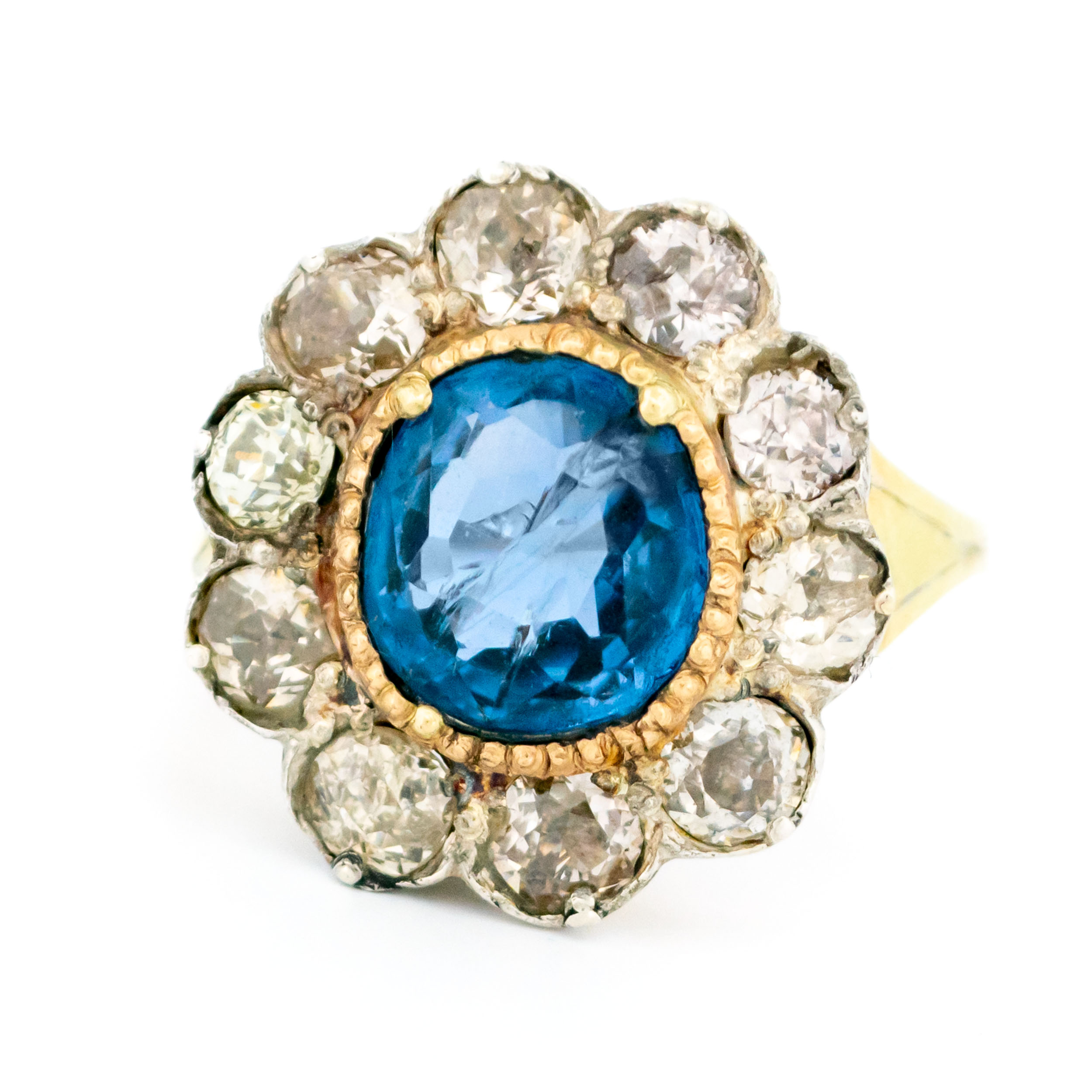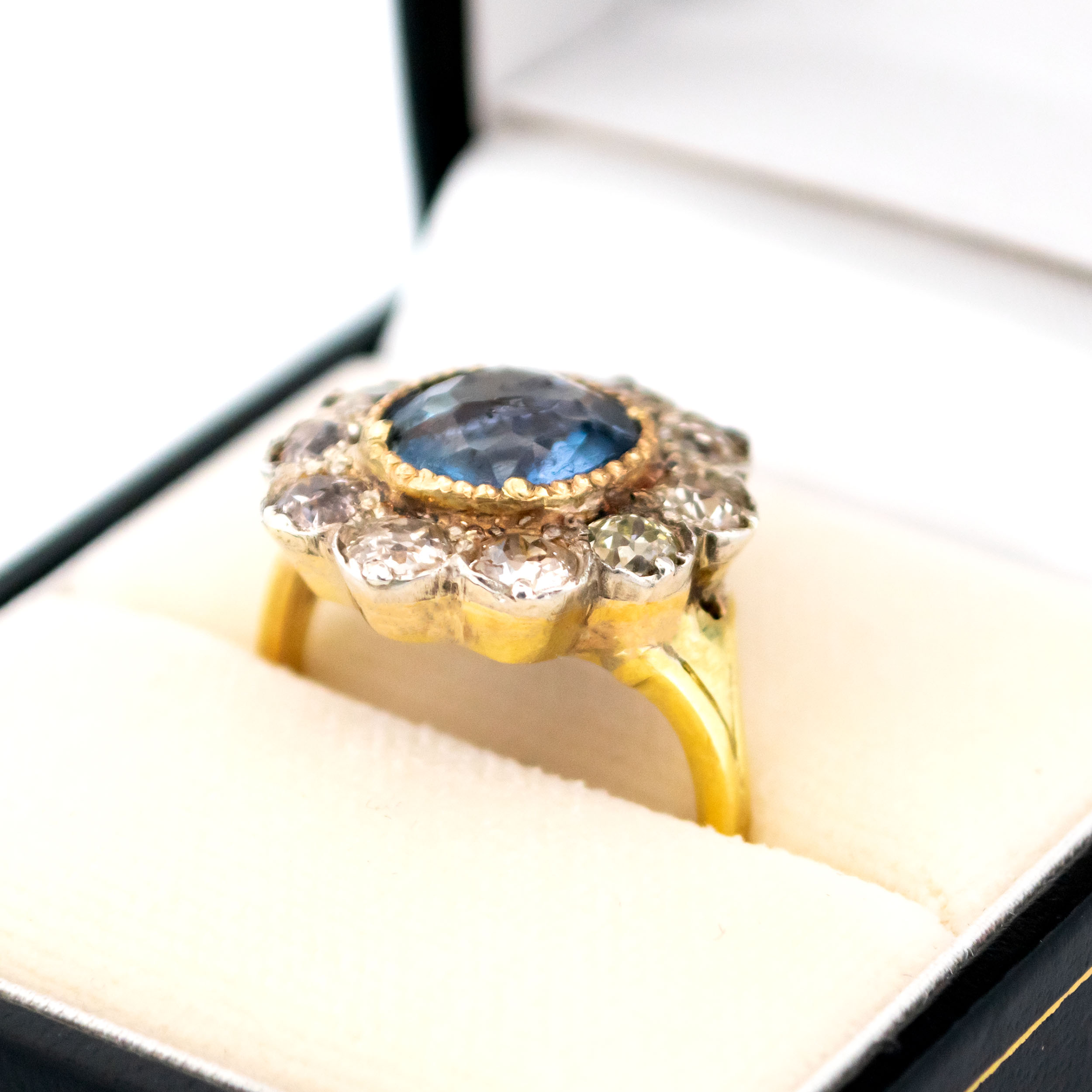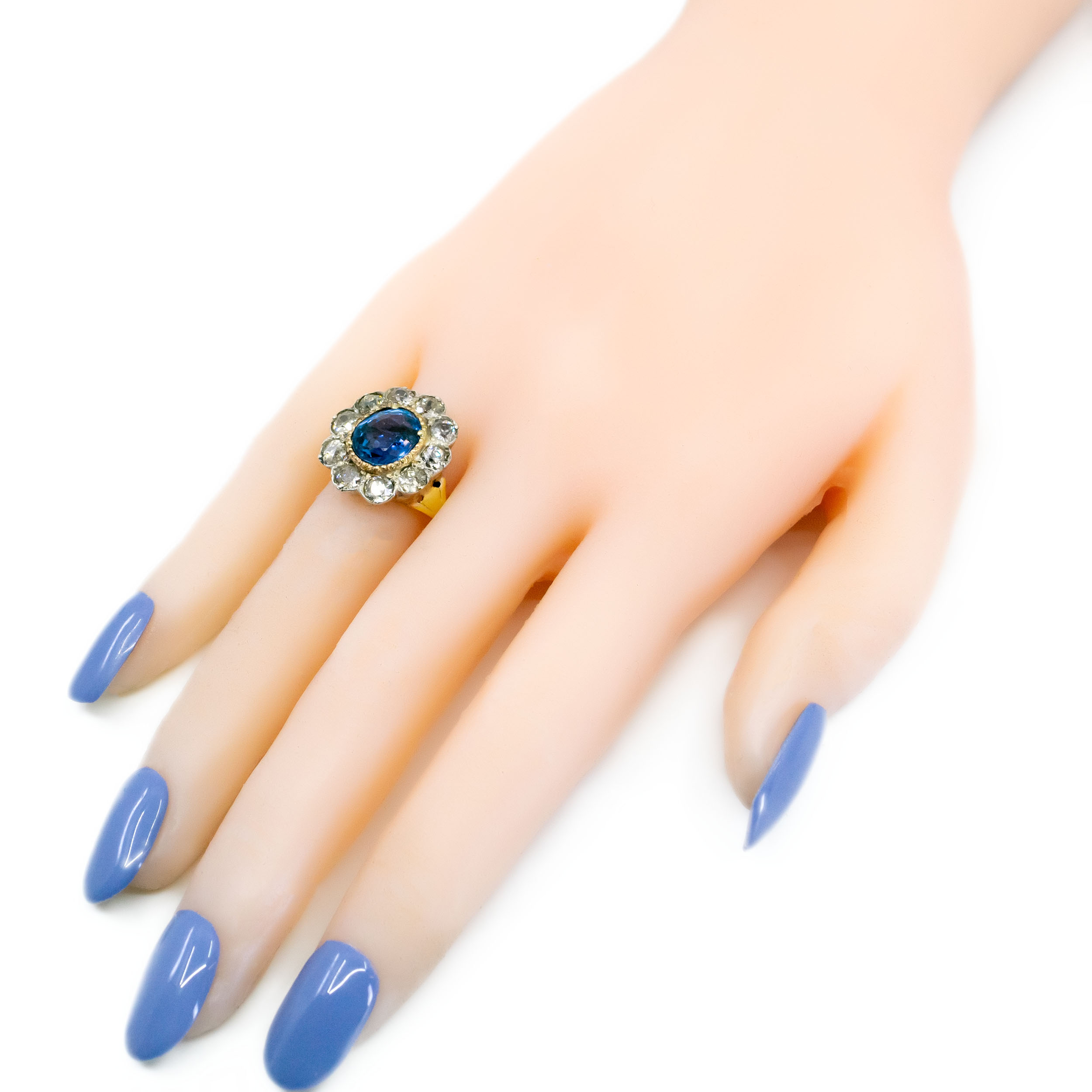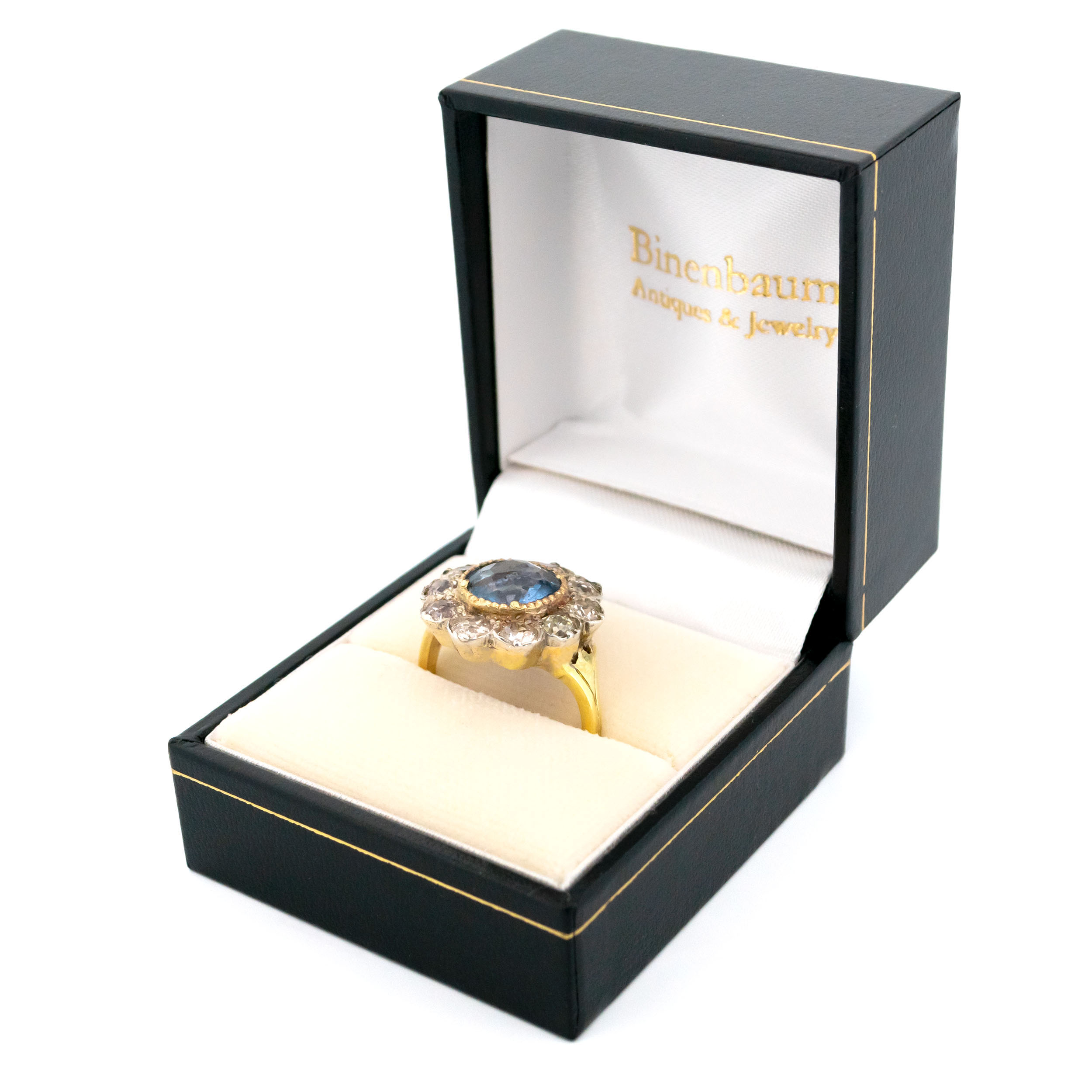Discover timeless elegance with this stunning Late Victorian cluster ring. ✨ It showcases a breathtaking 4.50ct sapphire at its heart, encircled by a radiant halo of approximately 2.00ct old-mine-cut diamonds (K, I1). Crafted to perfection in 18k gold and silver, this piece is an heirloom in the making. 💍✨
Details: ±4.50ct Sapphire, ±2,00ct. (K I1) Old-mine-cut diamonds, Silver, 14k, Silver Ring *.
Size: 17.73 NL / 55.7 FR / 7½ US / O½ UK, sizeable (Within reason. Contact seller for information).
Dimensions: Top 1,9×1.75 cm..
Weight in grams: 6.3.
Condition: Good condition – used with some signs of wear.
Shipping and Pickup: This classic piece ships from our store located in the center of Amsterdam, The Netherlands. We offer both registered shipping and local pickup at our store. In the case of local pickup, any applicable shipping costs will be refunded.
About Us: Add some sparkle to your style with Binenbaum.com. We offer a stunning selection of antique and vintage jewelry that you won’t find anywhere else. From timeless rings and dazzling necklaces to unique brooches, we have something for every taste and occasion. Visit our website today and treat yourself to a piece of history.
| Design Era | |
|---|---|
| Design & Historical Context | The Late Victorian or Aesthetic period was a time of great cultural and artistic flourishing in Europe and the United States, and this was reflected in the jewelry of the time. The Aesthetic movement, which emphasized beauty and art for art's sake, was particularly influential on jewelry design during this time. Late Victorian or Aesthetic period jewelry is known for its intricate detailing and use of precious materials such as gold, silver, and diamonds. It often featured motifs such as flowers, animals, and nature scenes, and was inspired by a variety of cultural movements, including the Arts and Crafts movement, which sought to return to traditional craftsmanship and natural materials. One of the most distinctive features of Late Victorian or Aesthetic period jewelry is its emphasis on the use of enamel. Enamel is a type of glass-like material that is fused to a metal surface, and it was often used to add color and detail to jewelry. The French firm, Cartier, was particularly known for its use of enamel in its Late Victorian or Aesthetic period pieces. Late Victorian or Aesthetic period jewelry remains popular and is highly collectible to this day. It is often associated with the elegance and refinement of the time period, and is often seen as a symbol of wealth and sophistication. |
| Key Materials | |
| Materials & Craftsmanship | Sapphire Sapphire is a mineral made from aluminum oxide that is known for its beautiful colors, including blue, pink, yellow, green, purple, and orange. The most popular variety of sapphire is blue sapphire, which has a medium to deep blue color and strong saturation. Blue sapphire is typically the most popular and most affordable of the three major precious gemstones (emerald, ruby, and sapphire) and is often used in a variety of different types of jewelry, including rings, earrings, pendants, and bracelets. Fancy sapphires, which are available in a variety of different colors, are often more rare and expensive than blue sapphires and are prized for their unique and beautiful colors. Sapphire is a very hard and durable gemstone, with a Mohs hardness of 9 out of 10, which makes it resistant to scratches and other types of damage. It is also believed to have various healing properties and is sometimes used in traditional medicine and meditation practices. Old-mine-cut diamond The old mine cut is a type of diamond cut that was popular in the 1700s and was most prevalent during the Georgian and Victorian eras. It is similar to today's cushion cut and is characterized by a squarish girdle with gently rounded corners, a high crown, a small table, and a large, flat culet. Old mine cut diamonds are known for their antique charm and character, and they are often used in vintage-style jewelry. They have a softer, more romantic look than modern diamond cuts, which tend to have more precise geometry and a higher level of brilliance. Old mine cut diamonds are typically less expensive than diamonds with more modern cuts because they require less labor and material to produce. They are often used as accent stones in jewelry designs or as the main gemstone in vintage-style pieces. Despite their lower price, old mine cut diamonds can still be beautiful and valuable, and they are a popular choice for those who appreciate the unique charm and character of antique jewelry. 14k 14k gold is a popular choice for use in jewelry because it is durable, yet still relatively affordable compared to higher karat golds like 18k or 24k. It is made up of 58.5% pure gold and is mixed with other metals to make it harder and more durable. 14k gold is available in a range of colors, including yellow, white, and rose, and is commonly used in a variety of jewelry pieces such as rings, earrings, necklaces, and bracelets. One of the advantages of 14k gold is that it is more resistant to wear and tear than pure gold, which makes it suitable for everyday wear. However, it is still softer than other alloys such as stainless steel or platinum, so it may require more maintenance to keep it looking its best. Overall, 14k gold is a popular choice for those who want the look and feel of gold, but at a more affordable price point. Silver Silver is a white metallic element that is known for its excellent conductivity of heat and electricity. It is represented on the periodic table of elements by the symbol Ag, and it is a member of the noble metals, which are known for their excellent resistance to oxidation. Silver is a relatively soft metal, with a hardness that is intermediate between gold and copper. It is more malleable and ductile than gold, which means that it can be easily shaped and molded into various forms. However, it is not as hard as copper, which means that it is more prone to scratches and other types of damage. Because of its softness, silver is usually alloyed with another metal to harden it enough to maintain the desired shape and details when it is used in jewelry and other decorative objects. This helps to give it the necessary strength and durability for use in these types of applications. Throughout history, silver has played a prominent role in the production of jewelry and objets d'art. It is prized for its beauty and versatility, and it is often used in a wide variety of different types of jewelry, including rings, earrings, pendants, and bracelets. It is also used in decorative objects, such as candlesticks, vases, and other decorative items. Silver Silver is a white metallic element that is known for its excellent conductivity of heat and electricity. It is represented on the periodic table of elements by the symbol Ag, and it is a member of the noble metals, which are known for their excellent resistance to oxidation. Silver is a relatively soft metal, with a hardness that is intermediate between gold and copper. It is more malleable and ductile than gold, which means that it can be easily shaped and molded into various forms. However, it is not as hard as copper, which means that it is more prone to scratches and other types of damage. Because of its softness, silver is usually alloyed with another metal to harden it enough to maintain the desired shape and details when it is used in jewelry and other decorative objects. This helps to give it the necessary strength and durability for use in these types of applications. Throughout history, silver has played a prominent role in the production of jewelry and objets d'art. It is prized for its beauty and versatility, and it is often used in a wide variety of different types of jewelry, including rings, earrings, pendants, and bracelets. It is also used in decorative objects, such as candlesticks, vases, and other decorative items. |
| Size | |
| Dimensions | Top 1,9×1.75 cm. |
| Gender | |
| Weight (in grams) | 6.3 |
| Condition |
Enhance the Beauty of Your Jewelry with Proper Care
Wearing your jewelry is a special way to express yourself and add a touch of personal style to any look. However, to ensure your jewelry remains in pristine condition, there are a few simple steps you need to take to keep it looking its best.
General Care Instructions:
Remove jewelry when showering or bathing, especially when at the beach, in the sea or in chlorinated water.
Avoid wearing jewelry while doing physical work such as housekeeping, gardening or exercise.
Storing your jewelry in a dry and cool place will help protect it from moisture, dirt and dust.
Keeping it away from harsh chemicals such as bleach, ammonia and chlorine will help to avoid discoloration and damage.
Cleaning your jewelry regularly with a soft cloth will help to keep it looking shiny and new.
Avoid exposing your jewelry to extreme temperatures, such as leaving it in direct sunlight or near a heater, as this can cause damage.
Handle your jewelry carefully and avoid dropping it, as this can cause the stones to loosen or the metals to scratch.
Finally, if possible, have your jewelry professionally checked and serviced. This will ensure that any potential problems are spotted and fixed before they become worse.
By following these tips, you can enjoy your precious jewelry for many years to come.
Related products
-
Diamond Platinum Pendant Earrings 5846-0616
€ 3.595,00 VAT incl. (where applicable) -
Diamond Sapphire Platinum Target Ring 6961-4858
€ 3.995,00 VAT incl. (where applicable) -
Diamond 14k Cluster Ring 6898-1835
€ 1.395,00 VAT incl. (where applicable) -
Agate Citrine 9k Antique Scottish Thistle Kilt Pin Brooch 8445-7059
€ 1.295,00 VAT incl. (where applicable) -
Diamond Sapphire 14k Deco Ring 7331-1947
€ 1.595,00 VAT incl. (where applicable) -
Diamond 14k Pear-Shape Ring 6995-1894
€ 6.695,00 VAT incl. (where applicable) -
Moonstone Diamond Platinum Square-Shape Ring 4489-4682
€ 2.995,00 VAT incl. (where applicable) -
Diamond Platinum Cluster Earrings 4977-4675
€ 3.395,00 VAT incl. (where applicable)
- Home
- Collection
- Fine Jewelry
- Silver Jewelry
- Silverware
- Boxes
- Candlesticks
- Salt and pepper shakers
- Miniatures
- Salt cellars
- Spoon Set
- Condiments
- Frames
- Napkin Ring
- Spoon
- Oddities
- Cups
- Vases
- Cutlery
- Serving Spoon And Cake Server
- Candlesticks
- Baskets
- Hanukkiah
- Spice Tower
- Yad
- Tea Set
- Sugar Castor
- Napkin Rings
- Wine Bottle Coaster
- Wine Stopper
- Tea Pot
- Jugs
- Rattles
- Hip Flask
- Miscellaneous
- Rings 💍
- About
- Contact























